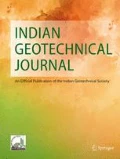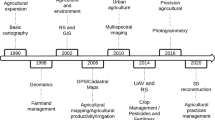Abstract
Expansive soils are those that expand and contract significantly when subjected to changes in moisture. The presence of such soils can accelerate the deterioration rate of pavements due to increased cracking and roughness, especially when Gilgai relief is allowed to manifest beneath the pavement structure. Gilgai relief is a naturally occurring topographical feature that results in a unique undulating ground surface. These undulations develop from deep seated swelling pressures within the underlying expansive soil layers. At present, current road roughness indices cannot isolate the roughness caused by Gilgai relief and the detection of Gilgai in the field can be difficult. This paper presents a new series of templates that can identify pavement sections that contain high concentrations of waveband roughness specific to Gilgai characteristics. These templates are based on the standard international roughness index and a variety of new calculated profile indices that measure waveband roughness quantities. The main outcome of this paper is that the influence of Gilgai relief can now be detected and quantified mathematically through these templates, which were developed from over 600 km of road profile data from flexible rural highway pavements located in north-west Victoria (Australia).








Similar content being viewed by others
References
Richards BG (1968) The role of environment in flexible pavement design. Civil Engineering Transactions, The Institution of Engineers, Australia, pp 197–205
Richards BG, Peter P, Emerson WW (1983) The effects of vegetation on the swelling and shrinking of soils in Australia. Geotechnique 33(2):129–139
Barry IM (1984) The influence of shrubs and trees on pavement loss of shape. VicRoads technical report, VicRoads, Australia, pp 1–27
Jameson GW (1986) Trees and pavement shape loss. In: Proceedings of the 13th Australian road research conference, part 4: pavements and construction, Australia, pp 93–106
Lopes D, Osman NY (2010) Changes of Thornthwaite’s total moisture indices in Victoria from 1948–2007 and the effect of seasonal foundation movements. Aust Geomech 45(1):37–48
Luo R, Prozzi JA (2011) Development of longitudinal cracks on pavement over shrinking expansive subgrade. Road Mater Pavement Des 11(4):807–832
Velasco MO, Lytton RL (1981) Pavement roughness on expansive clays, TRR790, Washington, DC, pp 78–87
Lytton RL, Boggess RL, Spotts JW (1976) Characteristics of expansive soil roughness of pavements, TRR568, Washington, DC, pp 9–23
Aitchison GD (1953) The mechanics of gilgai formation. In: Proceedings of the first Australian conference on soil science, vol 2, section 6, paper no. 25, Adelaide, Australia, pp 1–3
Beckman GG, Hubble GD, Thompson CH (1970) Gilgai forms, distribution and soil relationships in north-eastern Australia, presented at symposium on soils and earth structures in arid climates, paper no. 2898, May 21–22, The Institution of Engineers, Adelaide, Australia, pp 116–121
Bartelli LJ, McCormack DE (1976) Morphology and pedologic classification of swelling soils, TRR568, Washington, DC, pp 1–8
Maxwell B (1994) Influence of horizontal stresses on gilgai landforms. J Geotech Eng 120(8):1437–1443
Hallwsorth EG (1968) A handbook of Australian soils: X the gilgai phenomenon. Rellim Technical Publications, South Australia, pp 415–423
Smith RL (1993) Estimating soil movements in new areas. Presented at australian geomechanics society seminar: extending the code beyond residential slabs and footings, Victoria Branch, Melbourne, Australia, pp 1–6
Kassiff G, Holland JE (1966) The expansive properties of Dooen clays as applied to buried pipes. Civ Eng Trans 8(2):133–142
Blackburn G, Sleeman JR, Scharpenseel HW (1979) Radiocarbon measurements and soil micromorphology as guides to the formation of gilgai at Kaniva, Victoria. Aust J Soil Res 17:1–15
Knight MJ (1980) Structural analysis and mechanical origins of gilgai at Boorook, Victoria, Australia. Geoderma 23(4):245–283
Sayers MW, Gillespie TD, Queiroz CAV (1986) The international road roughness experiment: a basis for establishing a standard scale for road roughness measurements. Journal of the Transportation Research Board, Transportation Research Record No. 1084, Transportation Research Board of the National Academies, Washington, DC, pp 76–85
Sayers MW, Gillespie TD, Queiroz CA (1986) The international road roughness experiment: establishing correlation and a calibration standard for measurements. World Bank technical paper number 45, The World Bank, Washington, DC, USA
Sayers MW (1995) On the calculation of international roughness index from longitudinal road profile. Journal of the Transportation Research Board, Transportation Research Record No. 1501, National Research Council, Washington, DC, USA, pp 1–12
ASTM E1926 (1998) E1926 98: standard practice for computing international roughness index of roads from longitudinal profile measurements. ASTM International, Leyden
Sayers MW, Karamihas SM (1998) The little book of profiling: basic information about measuring and interpreting road profiles. The University of Michigan Transportation Research Institute, Ann Arbor
Hassan R, Evans R (2013) Road roughness characteristics in car and truck wheel tracks. Int J Pavement Eng 14(8):736–745
Butterworth S (1930) On the theory of filter amplifiers. Exp Wirel Wirel Eng 7:536–541
UMTRI (1997) RoadRuf: software for analysing road profiles. University of Michigan Transportation Research Institute, Ann Arbor
Evans RP (2013) Synchronisation of road profile data and the assessment of road roughness using waveband analysis. PhD Dissertation, Swinburne University of Technology, Melbourne, Australia
Mann A, McManus KJ, Evans RP (1998) The use of power spectral density analysis to determine deterioration modes in pavement structures. In: Proceedings of the 9th REAAA conference, Wellington, New Zealand, vol 2, pp 263–268
ISO 8608 (1995) ISO 8608 mechanical vibration—road surface profiles—reporting of measured data. International Organization of Standardization, Geneva
Acknowledgments
The authors would like to thank Mr. Ian Cossens from the Pavement Asset Management Group, VicRoads, who spent much time explaining the State Road Referencing System as well as assisting with the extraction of maintenance records for the test sites. I also acknowledge and appreciate VicRoads for purchasing the required raw longitudinal road profiles measured during the 2007 survey, which was ultimately used to develop the templates presented in this paper.
Author information
Authors and Affiliations
Corresponding author
Rights and permissions
About this article
Cite this article
Evans, R.P., Arulrajah, A. & Horpibulsuk, S. Detecting Gilgai Relief Beneath Sealed Flexible Pavements Using Road Profile and Road Roughness Measurements. Indian Geotech J 45, 431–440 (2015). https://doi.org/10.1007/s40098-015-0164-4
Received:
Accepted:
Published:
Issue Date:
DOI: https://doi.org/10.1007/s40098-015-0164-4




